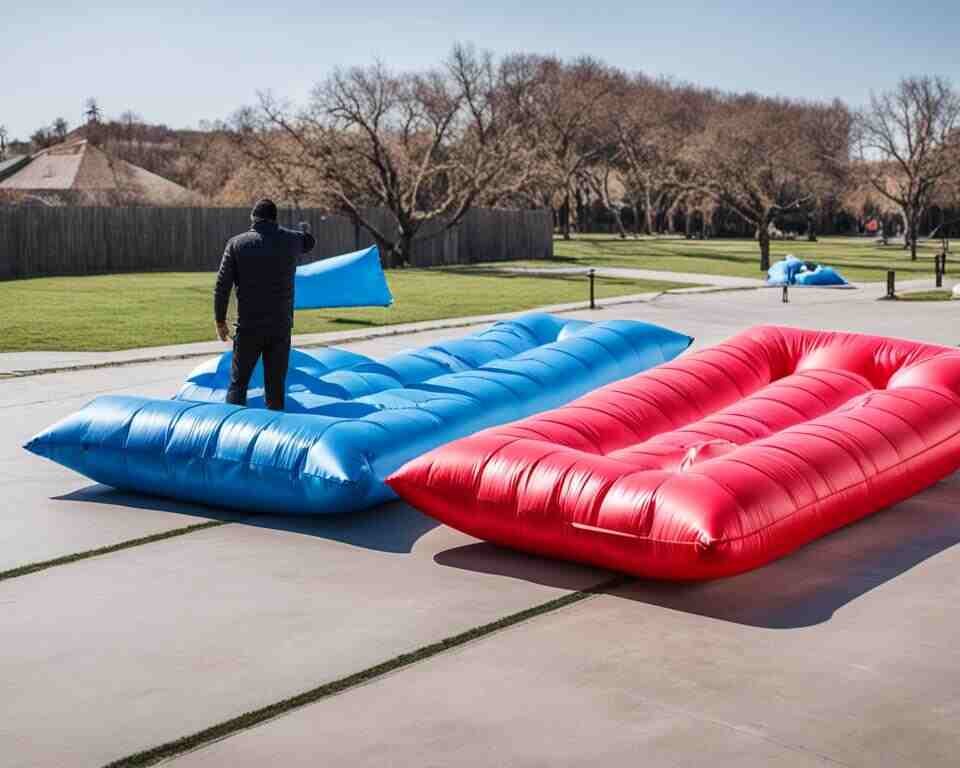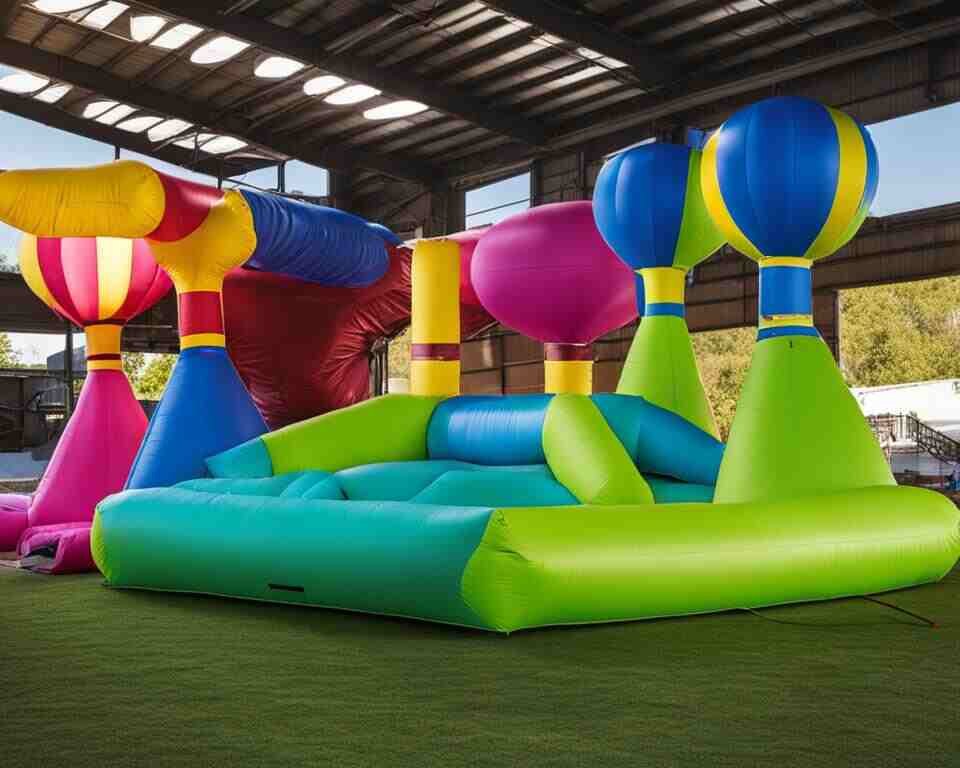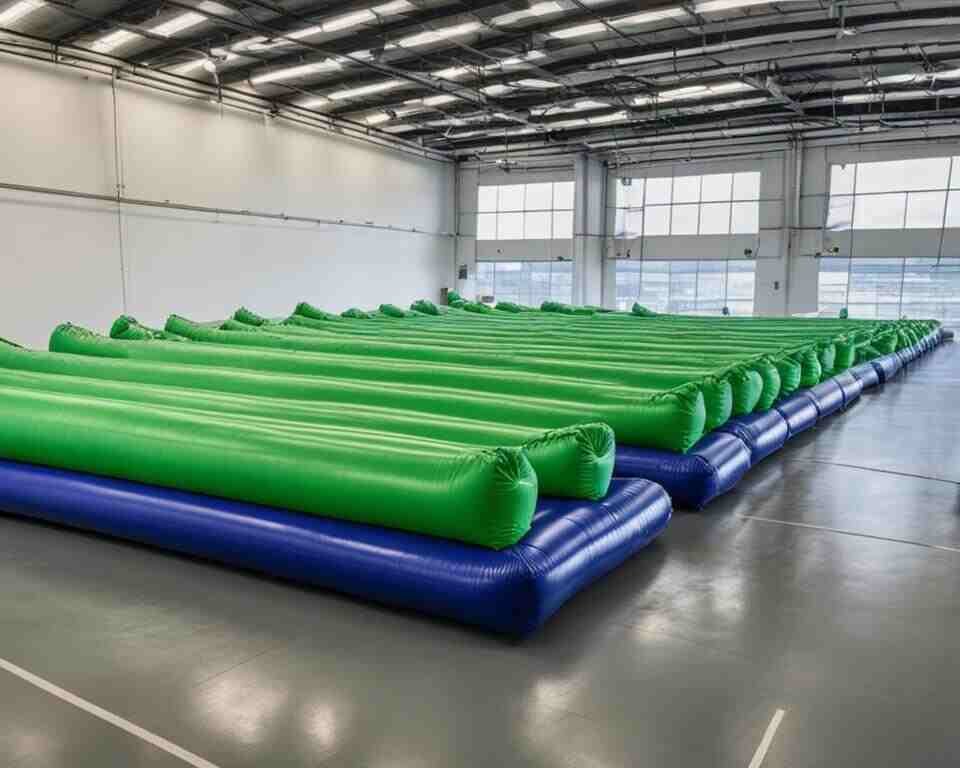Inflatables are a fantastic addition to any outdoor gathering or water activity. Whether it’s a bouncy castle, inflatable pool, or water slide, these fun-filled products bring joy and entertainment to both children and adults.
However, after a day of excitement, it’s essential to properly dry out your inflatables to maintain their longevity and prevent mold or mildew growth. In this article, I’ll provide expert tips and tricks on how to dry out inflatables quickly, ensuring they stay in excellent condition for years to come.
- Follow these expert tips to efficiently dry out your inflatables
- Properly drying your inflatables helps prevent mold and mildew growth
- Choose an ideal drying area and utilize innovative tools and equipment
- Understand the risks of improper drying and the importance of maintenance
- Learn quick drying techniques and strategies for specific inflatable types

Understanding the Importance of Properly Drying Inflatables
In this section, we will explore why properly drying inflatables is crucial to their longevity and maintenance. We will also discuss the risks associated with improper drying techniques and how to prevent mold and mildew growth on your inflatables.
The Risks of Improper Drying
Improperly drying inflatables can pose several risks to their overall condition. When inflatables are not dried thoroughly, excess moisture can remain trapped within the material, leading to mold and mildew growth. This can not only damage the appearance of the inflatables but also compromise their structural integrity. Mold and mildew can cause stains, odors, and even weaken the fabric, resulting in potential leaks or tears.
The Longevity and Maintenance of Your Inflatable Products
Properly drying your inflatables is essential for ensuring their longevity and maximizing their lifespan. By removing excess moisture after each use, you can prevent the accumulation of mold and mildew, which can significantly extend the life of your inflatables. With regular maintenance, including proper drying techniques, inflatables can remain in excellent condition for years, providing continued enjoyment for you and your family.
Preventing Mold and Mildew Growth on Inflatables
To prevent mold and mildew growth on your inflatables, it is crucial to follow effective drying practices. After use, thoroughly dry your inflatables by ensuring all surfaces are completely moisture-free. This can be achieved by wiping them down with a clean cloth or towel, or by letting them air dry in a well-ventilated area. Avoid storing inflatables in damp or humid environments, as this can promote the growth of mold and mildew. Regularly inspect your inflatables for any signs of mold or mildew and address them promptly to prevent further damage.

Initial Steps for Efficient Inflatable Drying
In this section, I will guide you through the initial steps for efficient inflatable drying. Properly disassembling and preparing your inflatables for drying, as well as removing excess water and choosing an ideal drying area, are crucial for ensuring a thorough and effective drying process.
Disassembling and Preparing Inflatables for Drying
Before starting the drying process, it’s important to disassemble your inflatables properly. This means removing any detachable components such as covers, valves, or accessories. Check for any stubborn dirt or debris and clean the inflatables thoroughly.
Removing Excess Water Post Usage
After the disassembly, it’s important to remove excess water from your inflatables. Start by gently squeezing and pressing the inflated areas to wring out as much water as possible. You can also use absorbent towels or sponges to soak up the water from the surface. Be thorough in this step to ensure all excess water is removed.
Choosing an Ideal Drying Area
Once you have disassembled and removed excess water from your inflatables, it’s time to choose an ideal drying area. Look for a well-ventilated space with good airflow and preferably indirect sunlight. Avoid placing inflatables in direct sunlight as this can cause fading and damage to the material. Make sure the area is clean, dry, and free from any sharp objects that could puncture the inflatables.
By following these initial steps, you’ll be well on your way to effectively drying your inflatables and ensuring their longevity and quality.
Quick Drying Techniques for Inflatables
In this section, I will share various methods and tips for quickly drying inflatables. These techniques are specially designed to expedite the drying process, allowing you to dry your inflatables in a shorter amount of time.
One effective method is to use absorbent towels or sponges to soak up any excess water from the surface of the inflatable. Gently press the towels or sponges onto the wet areas, absorbing as much moisture as possible. This will help speed up the drying process and prevent any water spots from forming.
Another quick drying technique is to utilize air movers or blowers. These powerful tools can generate a strong airflow that helps evaporate moisture from the inflatable’s surface. Position the air mover or blower at a suitable distance from the inflatable and adjust the airflow intensity as needed. Ensure that the inflated part of the inflatable is exposed to the airflow for faster drying.
When drying larger inflatables, consider using a dehumidifier in conjunction with air movers or blowers. Dehumidifiers help remove excess moisture from the air, creating an environment that promotes faster drying. Place the dehumidifier near the inflatable and adjust the humidity level according to the manufacturer’s instructions.
Lastly, it’s important to choose an ideal drying area for your inflatables. Look for a well-ventilated space with good air circulation. This will aid in the natural evaporation of moisture. Avoid drying inflatables in direct sunlight, as this can cause damage to the material. Instead, opt for a shaded area that still allows for airflow.
By implementing these quick drying techniques, you can ensure that your inflatables are ready for storage or immediate use in no time. Remember to always follow the manufacturer’s instructions and take proper care of your inflatables to maximize their lifespan.

Innovative Tools and Equipment for Speeding Up Drying
When it comes to drying inflatables quickly and efficiently, having the right tools and equipment can make all the difference. In this section, we will explore innovative options that can help expedite the drying process, saving you time and effort.
Utilizing Air Movers and Blowers
Air movers and blowers are powerful tools specifically designed to accelerate the drying process. By generating a constant flow of high-velocity air, these tools effectively remove moisture from the surface of inflatables. They can reach tight spaces and crevices, ensuring thorough drying and preventing the growth of mold and mildew.
When using air movers and blowers, it’s important to position them strategically to maximize airflow. By placing them in close proximity to the inflatable, you can direct the airflow directly onto the surface, expediting the drying process.
The Role of Dehumidifiers in Drying Inflatables
Dehumidifiers play a crucial role in maintaining optimal drying conditions for inflatables. These devices effectively reduce humidity levels in the surrounding environment, preventing moisture buildup on the surface of the inflatables.
By extracting excess moisture from the air, dehumidifiers help speed up the drying process and create a less favorable environment for mold and mildew growth. They are especially useful in areas with high levels of humidity or inadequate ventilation.
Effective Use of Absorbent Towels and Sponges
In addition to specialized tools, absorbent towels and sponges can also be valuable allies in the inflatable drying process. These items are designed to soak up moisture, making them ideal for removing any remaining water from the surface of the inflatables.
After using air movers, blowers, or dehumidifiers, gently pat the surface of the inflatables with absorbent towels or sponges to absorb any remaining moisture. This final step helps ensure a thorough drying process and minimizes the risk of mold or mildew development.
| Tool | Advantages | Disadvantages |
|---|---|---|
| Air Movers | Powerful airflow Effective drying in tight spaces Prevents mold and mildew growth | Might require access to electricity Can be noisy |
| Blowers | High-velocity air Thorough drying of surface Quick drying time | Might require access to electricity Not suitable for delicate or porous materials |
| Dehumidifiers | Reduces humidity levels Accelerates drying process Prevents moisture buildup | Requires access to electricity Higher upfront cost |
| Absorbent Towels and Sponges | Soaks up moisture Leaves surfaces dry Minimizes mold and mildew risk | Manual labor Requires regular cleaning |
Expert Strategies for Drying Specific Inflatable Types
When it comes to drying specific types of inflatables, it’s important to consider their unique characteristics and requirements. Whether you’re dealing with inflatable toys, watercraft, or other common inflatable products, using the right techniques can ensure effective drying and help extend their lifespan. Here are some expert strategies and tips for drying different types of inflatables:
Drying Inflatable Toys
Inflatable toys can come in various shapes and sizes, making the drying process slightly different for each type. Here’s how you can effectively dry inflatable toys:
- Deflate the toy completely and remove any excess water using a towel or sponge.
- Wipe down the surface of the toy to remove any moisture.
- Hang the deflated toy in a well-ventilated area or use a fan to facilitate faster drying.
Drying Inflatable Watercraft
Inflatable watercraft, such as kayaks or paddleboards, require proper drying to prevent damage and mildew growth. Here’s what you should do:
- Remove all accessories and rinse the watercraft with fresh water to remove any salt or dirt.
- Deflate the watercraft and allow it to dry naturally in a shaded area to avoid prolonged sun exposure.
- Once dry, inspect the seams and valves for any moisture and wipe them clean.
Inflatable Drying Techniques
Regardless of the type of inflatable, there are general techniques that can help optimize the drying process. Here are a few inflatable drying techniques to keep in mind:
- Elevate the inflatables off the ground using racks or stands to promote airflow.
- Open any valves or zipper compartments to allow air circulation inside the inflatable.
- Rotate the inflatables regularly to ensure all surfaces are exposed to airflow.
By following these expert strategies and tips, you can effectively dry specific types of inflatables and prolong their lifespan. Remember to always consider the unique characteristics and requirements of each inflatable type to ensure optimal drying results.

How to Dry Out Inflatables
In order to effectively dry out your inflatables, it is important to consider the techniques and considerations that will promote efficient drying. Strategically placing your inflatables to maximize airflow and choosing between sun drying and shade drying are key factors to take into account.
Strategically Placing Inflatables for Optimal Airflow
When drying out your inflatables, it is essential to position them in a way that allows for optimal airflow. This will help expedite the drying process and prevent the accumulation of moisture, which can lead to mold and mildew growth. Here are a few tips for strategically placing your inflatables:
- Ensure there is enough space between each inflatable to facilitate proper airflow.
- Place the inflatables in an open area, avoiding any obstructions that may block airflow.
- Elevate the inflatables off the ground using a sturdy and stable surface to further enhance airflow.
By strategically placing your inflatables, you can create an environment that promotes optimal drying conditions, allowing for faster and more effective drying.
Sun Drying vs. Shade Drying: Which is Better?
When it comes to drying inflatables, both sun drying and shade drying have their advantages and considerations. Here’s a breakdown of the pros and cons of each method:
Sun Drying
Sun drying is a popular method that harnesses the natural heat and sunlight to dry out inflatables. The benefits of sun drying include:
- High temperatures and direct sunlight can quickly evaporate moisture from the inflatables.
- The UV rays from the sun can help kill bacteria and prevent the growth of mold and mildew.
However, there are a few factors to consider when sun drying your inflatables:
- Excessive exposure to direct sunlight may cause fading or damage to the colors and materials of your inflatables.
- Overheating due to prolonged sun exposure can affect the structural integrity of the inflatables.
Shade Drying
Shade drying offers a more controlled environment for drying your inflatables. Some benefits of shade drying include:
- Protection from excessive sun exposure helps preserve the colors and materials of the inflatables.
- Shade drying prevents overheating, which can be a concern with direct sun drying.
However, shade drying may take slightly longer compared to sun drying due to the absence of direct sunlight and higher temperatures.
When deciding between sun drying and shade drying, consider the specific needs and characteristics of your inflatables. If color preservation is a priority, shade drying may be the better option. On the other hand, if you’re looking for faster drying times, sun drying can be more effective.
Ensure the image is placed centrally and visually enhances the section.
Complete table example:
| Sun Drying | Shade Drying | |
|---|---|---|
| Advantages | High temperatures and direct sunlight expedite drying | Preserves colors and materials |
| Considerations | Potential color fading and structural damage | Longer drying times |
Conclusion
Properly drying your inflatables is essential for their longevity and maintenance. By following the expert tips and techniques discussed in this article, you can ensure that your inflatables remain in top condition and free from mold and mildew growth.
Throughout the article, we have highlighted the risks of improper drying and the importance of choosing an ideal drying area. We have also explored quick drying techniques and innovative tools that can help expedite the drying process.
Remember to strategically place your inflatables to maximize airflow and consider whether sun drying or shade drying is more suitable for your needs. By implementing these strategies and tips, you can save time and ensure that your inflatables are ready for the next use.
Here’s to happy and well-maintained inflatables!

